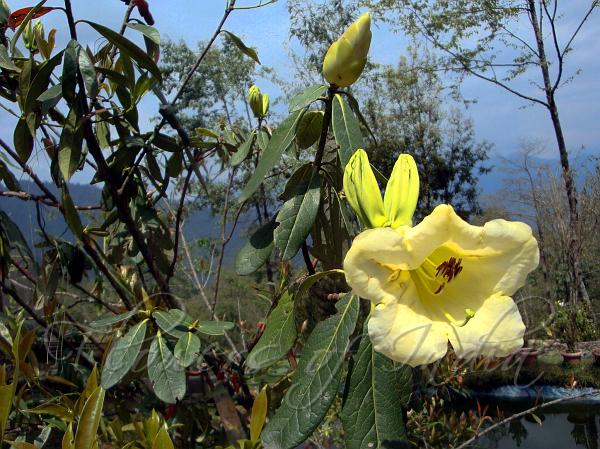|
| Lady Dalhousie Rhododendron |
|

|

| File size | 923371 |
| Original date | 4/15/11 10:16 AM |
| Resolution | 2048 x 1536 |
| Flash | Flash did not fire, auto |
| Focal length | 5.0mm |
| Exposure time | 1/200s |
| Aperture | 8.0 |
| Focus Distance | |
| Metering Mode | Multi-segment |
| Camera make | SONY |
| Camera model | DSC-W150 |
| Sensor type |
|
|
|
|
Photo: |
Botanical name: Rhododendron dalhousieae Family: Ericaceae (Blueberry family)
Synonyms: Rhododendron dalhousieae var. dalhousieae, Azalea macrocarpa
Synonyms: Rhododendron dalhousieae var. dalhousieae, Azalea macrocarpa
Lady Dalhousie Rhododendron was described by
Hooker, the botanist who first introduced it in 1850, to be the noblest
species of all Rhododendrons. It was named in the honor of Lady
Dalhousie, wife of the then Governor-General of India. It is a
straggling shrub, 6-8 ft high, growing on rocks or upon the trunks of
large trees. The stems are clothed with a reddish papery bark, the
branches straggling, patent,whorled, the whorls distant; each branch
bearing its leaves and flowers only at the ends. Leaves are few, patent
or reflexed, stalked, about 4.5-5 inches in length, elliptical-obovate,
somewhat leathery. The upper surface is darkish-green, inclining to a
yellow hue, even on the surface, beneath paler, dotted with very
minute, scattered, rusty-coloured- scales. Flowers are borne in groups
of 3-7 at the ends of branches. The stalk carrying the cluster is
nearly an inch long, stout, cylindrical, downy. Flowers are very large,
3.5-4.5 inches long, and as broad at the mouth, bell-shaped, yellowish
turning white, with an occasional tinge of rose. Flowers are very
fragrant too. Lobes of the limb are nearly equal, very broad, rounded,
waved, spreading. Sepal-tube is large, deeply divided almost to the
base into five ovate-elliptical, very blunt, spreading, leaf-like
sepals.Stamens are ten - filaments longer than the tube, curved
upwards, downy below. Anther are oblong-ovate, dark purple-brown. Ovary
is ovate, five-celled, tapering into the thickened style, which is
longer than the stamens. Stigma is a round, convex disk. Lady Dalhousie
Rhododendron is found in Eastern Himalayas, from C. Nepal to Arunachal
Pradesh, at altitudes of 2000-2500 m. Flowering: May-June.
| Identification credit: Sanjyoti Subba | Photographed in Pangthang, Sikkim. |
• Is this flower misidentified? If yes,